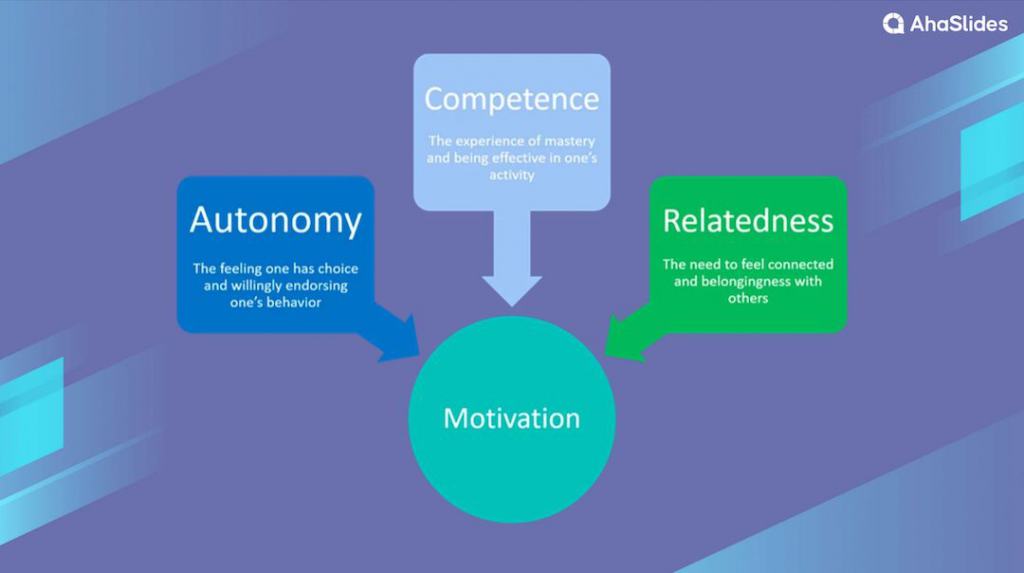What truly inspires your best work? Is it a big bonus or the fear of failure?
While external incentives may get short-term results, true motivation comes from within - and that's exactly what self-determination theory is all about.
Join us as we dive into the science behind what makes us completely absorbed in what we love. Discover simple ways to fuel your passion and unlock your most engaged self using the surprising insights of self-determination theory.

Table of Contents
- Self-Determination Theory Defined
- How Self-Determination Theory Works
- Self-Determination Theory Examples
- How to Improve Your Self-Determination
- Takeaway
- Frequently Asked Questions
Tips for Better Engagement

Get your Employees Engaged
Start meaningful discussion, get useful feedback and appreciate your employees. Sign up to take free AhaSlides template
🚀 Grab Free Quiz☁️
Self-Determination Theory Defined

Self-determination theory (SDT) is about what motivates us and drives our behaviour. It was proposed and developed primarily by Edward Deci and Richard Ryan in 1985.
At its core, SDT says we all have basic psychological needs to feel:
- Competent (able to do things effectively)
- Autonomous (in control of our own actions)
- Relatedness (connect with others)
When these needs are satisfied, we feel motivated and happy from within - this is called intrinsic motivation.
However, our environment plays a big role too. Environments that support our needs for competence, autonomy and social connection boost intrinsic motivation.
Things like choice, feedback and understanding from others help fulfil these needs.
On the other hand, environments that don't support our needs can damage intrinsic motivation. Pressure, control or isolation from others can undermine our basic psychological needs.
SDT also explains how external rewards sometimes backfire. While they may drive behaviour in the short term, rewards undermine intrinsic motivation if they curb our feelings of autonomy and competence.
How Self-Determination Theory Works

We all have an innate desire to grow, learn new things, and feel in control of our own lives (autonomy). We also want positive connections with others and to contribute value (relatedness and competence).
When these basic needs are supported, we feel more motivated and happy from the inside. But when they are blocked, our motivation suffers.
Motivation exists on a continuum from amotivated (lack of intent) to extrinsic motivation to intrinsic motivation. Extrinsic motives driven by reward and punishment are considered "controlled".
Intrinsic motives arising from interest and enjoyment are seen as "autonomous". SDT says supporting our inner drive is best for our well-being and performance.

Different environments can either nourish or neglect our basic needs. Places that offer choices and understanding make us more driven, focused and skilful from within ourselves.
Controlling environments make us feel pushed around, so we lose our inner zest and do things for external reasons like avoiding trouble. Over time this drains us.
Each person has their own style of adapting to circumstances (causality orientations) and what goals motivate them intrinsically vs. extrinsically.
When our basic needs are respected, especially when we feel free to choose, we do better mentally and accomplish more compared to when we are controlled externally.
Self-Determination Theory Examples

To give you a better context of how it works in real life, here are some examples of self-determination theory in school/work:
In school:
A student who studies for a test because they are intrinsically interested in the subject material, find it personally meaningful, and want to learn is displaying autonomous motivation according to SDT.
A student who studies only because they fear punishment from their parents if they fail, or because they want to impress their teacher, is displaying controlled motivation.
In work:
An employee who volunteers for additional projects at work because they find the work engaging and it aligns with their personal values is exhibiting autonomous motivation from an SDT perspective.
An employee who only works overtime to earn a bonus, avoid their boss's wrath, or look good for a promotion is demonstrating controlled motivation.
In medical context:
A patient who only follows the treatment to avoid being chastised by medical staff or out of fear of negative health consequences is displaying controlled motivation as defined by SDT.
A patient who adheres to their doctor's treatment plan, because they understand its personal importance for their health and long-term well-being, is autonomously motivated.
How to Improve Your Self-Determination
Regularly practising these actions will help you to naturally satisfy your needs for competence, autonomy, and relatedness and thus, develop into your most engaged and productive self.
#1. Focus on intrinsic motivation

To set intrinsically motivated goals, reflect on your core values, passions and what gives you a sense of meaning, flow or pride in accomplishing. Choose goals aligned with these deeper interests.
Well-internalised extrinsic goals can also be autonomous if the external benefits are fully identified with and integrated into your sense of self. For example, choosing a high-paying job you find truly engaging and purposeful.
Goals will likely change over time as you evolve. Periodically re-evaluate if they still ignite your intrinsic enthusiasm or if new avenues now call you. Be willing to adjust the course as needed.
#2. Build competence and autonomy

Continuously stretch your abilities in areas aligned with your values and talents through challenges that promote gradual mastery. Competence comes from learning at the edge of your skills.
Seek feedback and guidance, but don't rely solely on external evaluation. Develop internal metrics for improvement based on personal potential and excellence standards.
Make decisions for self-motivated reasons linked to your aspirations rather than for compliance or rewards. Feel ownership over your behaviours
Surround yourself with autonomy-supportive relationships where you feel understood and empowered to direct your life purposefully based on who you are becoming.
#3. Satisfy your psychological needs

Cultivate relationships where you feel truly seen, accepted unconditionally and empowered to express yourself authentically without fear of retribution.
Regular self-reflection on internal states, values, limitations and goals will illuminate energising versus draining influences to seek out or avoid.
Prioritise leisure activities simply for enjoyment and recharge rather than checking off boxes. Intrinsic hobbies feed the spirit.
External rewards like money, praise and such, are best seen as valued benefits rather than the primary driver for a behaviour to maintain intrinsic motives.
Takeaway
Self-determination theory provides valuable insights into human motivation and well-being. May this understanding of SDT empower you to actualise your strongest, most fully integrated self. The rewards - for spirit and performance - are well worth the effort to keep your inner fire burning bright.
Frequently Asked Questions
Who proposed the self-determination theory?
Self-determination theory was originally proposed by the seminal work of psychologists Edward Deci and Richard Ryan starting in the 1970s.
Is self-determination theory constructivist?
While not fully falling under the umbrella of constructivism, SDT does integrate some of constructivism's insights about the active role of cognition in building motivations versus just responding to external stimuli.
What is an example of self-determination theory?
An example of self-determined behaviours could be a student registering for an art club because they enjoy drawing, or a husband doing the dishes because he wants to share the responsibility with his wife.








